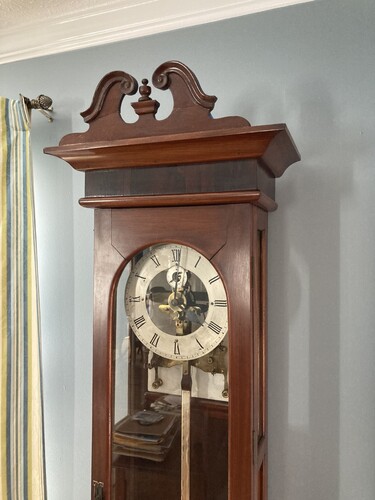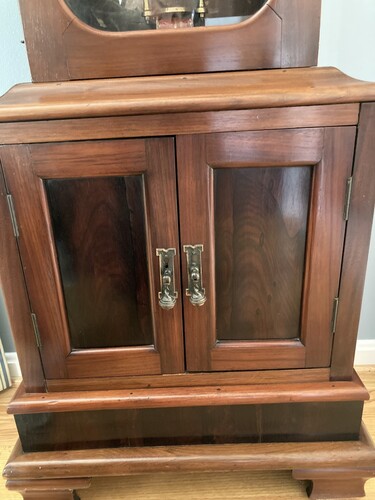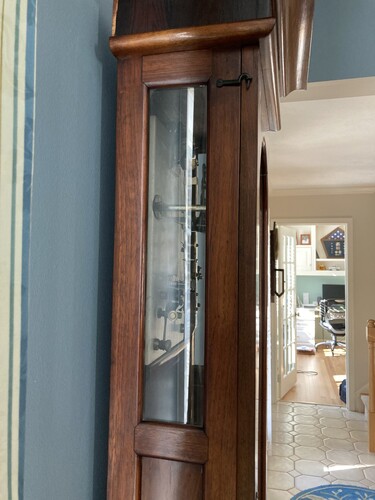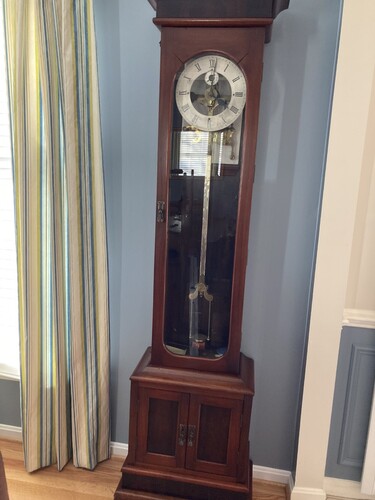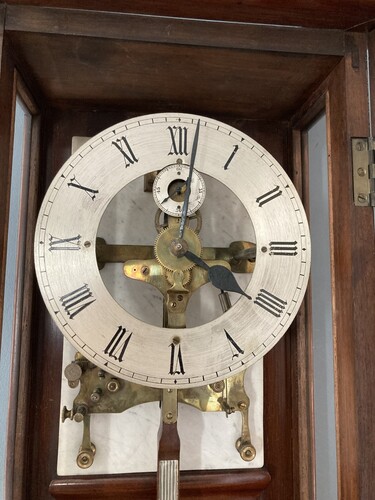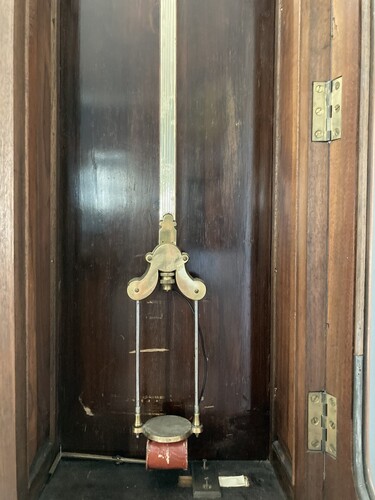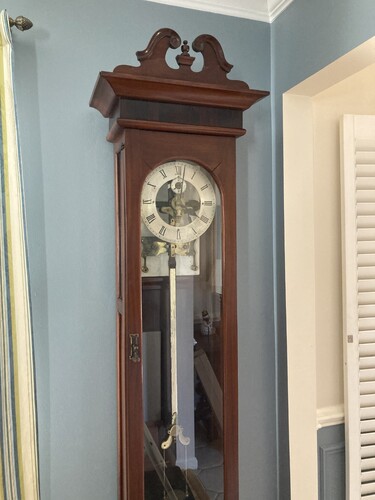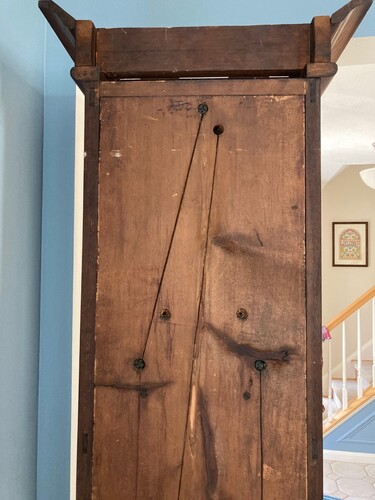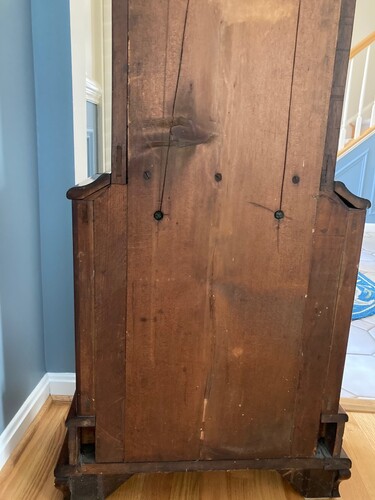Electric-assisted mahogany grandfather's clock with small bonnet. Battery-run with complex mechanical works. Needs repair
Purchased in Windermere, England in 1986.


Hello Gayle,
Thank you for sending in this most interesting floor clock to mearto.com for an appraisal. I am a bit uncertain about the origins of this standing floor clock and electro-physics is a bit far from my specialty. However, I will give it my best effort.
TITLE:
Mahogany cased, earth battery master time clock, supported by battery power, unsigned, but made in the style of, and attributed to the Peter Bentley Engineering Company, Leicester England circa 1910-1920.
DESCRIPTION:
The clock:
This master clock has the unusual distinction of having been designed for use with an earth battery (as had the earlier clocks of Alexander Bain). The energy driving the clock was originally obtained firm placement of electrodes into the earth and later from a zinc carbon couple buried 3-4 ft deep and 1 ft apart in moist soil, which is said to provide a potential of approximately 1 volt at the clock terminals. {An example in the Museum and Art Gallery of Leicester ran for forty years without attention on its original installation before being serviced in 1950.} A more conventional modern battery can, however, be substituted, as I suppose it is here, perhaps in the lower two door cabinet. The patent for this type of clock design was taken out by Percival Arthur Bentley in 1910 with the Bentley Manufacturing Company being formed shortly afterwards in order to commence their production. The factory was situated at Forest Gate, Clarendon Park Road, Leicester. Unfortunately the outbreak of the First World War halted the manufacture of this clock in September, 1914, but the firm moved to the Queens Road Factory, also in Leicester and undertook heavy commitments to help the war effort.
According to a former apprentice, performance was always much more reliable if a properly constructed earth battery was used. The fluctuating voltage of Leclanche cells adversely affected the timekeeping. The Electrical Review, 13th October, 1911, stated that with 1 volt p.d. at the clock terminal from an earth battery, the Bentley Clock kept time to within one minute a year. Commentary by Professor J. H. Gurney on 8th July, 1912 ... “The point in which no other electric clock on the market can compete with it is its accuracy of time-keeping. This depends in the first place on the constancy of current from a properly laid earth battery (no ordinary battery, even if its temperature could be maintained constant, can give so constant an E.M.F. without constant attention) and secondly on the excellence of workmanship in every detail. It is a luxury to have a clock which requires no attention whatever, and may be depended upon never to fail and which, when once regulated, will not have a rate variation from day to day.”
The battery and electrical charge is received at the base of the clock just below the pan type of pendulum bob held by two metal rods at the base of the rod. The pendulum swinging connects and disconnects the electrical charge that drives this type of master clock. The bob looks like a scale since weights can be applied to make it run faster and slower. In the back of the case there are wires that leave the system from a metal contact point and can be connected to several slave clocks. The wire runs from c1ock contacts to the slave contact terminals to power the slave clocks, and the accuracy is enhanced by the earth battery or in this example the chemical batter which supplanted the ground itself.
I have attributed this clock to Bentley mainly because of the skeletonized type of dial and subsidiary seconds dial. There were other companies soon popping up in in England and America using the same principle and the clock could have been made by these later master/slave clockmakers. There are some minor variations in the movements but as these are rare clocks there is no merit in being fussy. In common with many manufacturers, number of the movements did not commence with No. 1 and it is doubtful if more than about seventy were ever manufactured. Further details on these clocks can be found in the article entitled 'The Earth Driven Clock' by Dr. F.G.A. Shenton which appeared in the December, 1972, issue of Antiquarian Horology. Extremely rare clocks and although they do not play such as important role in the evolution of electrical horology they do seem to compete in scarcity and value with a Bain master clock if in a handsome case.
The dial is a skeletonized silvered brass dial with Gothic Roman hours (similar to the numerals of German cuckoo clocks) and that took me down the road to German clockmakers which I finally discarded. There is a subsidiary dial under the twelve and has ebonized spade hands. The clock is unsigned. The movement behind the dial is quite similar and minimalistic and there are electrical contacts behind the dial as well as below it.
COMPARABLES:
https://www.liveauctioneers.com/item/98051631_gillett-and-johnston-electric-master-clock-with-matching (sold for $2215 in 2021)
https://www.liveauctioneers.com/item/98051606_an-early-mercer-chronometers-pendulum-electric-master (sold for $1730 in 2021)
https://www.liveauctioneers.com/item/56451627_rare-oak-synchronome-master-clock (sold for $1700 in 2017)
https://www.liveauctioneers.com/item/56451562_warren-telechron-type-a-master-clock (sold for 41500 in 2017)
EARLY HISTORY OF EARTH POWERED ELECTROMAGNETIC MASTER CLOCKS:
One of the world's first electric clocks, was designed and built by Scottish inventor Alexander Bain. Its pendulum was driven by an 'earth battery' that consisted of two electrodes buried in the moist ground, and it could be connected electrically to other clocks, functioning as a central 'governor' transmitting time to geographically distant locations.
Between 1841 and 1852 Scottish-born Alexander Bain (1810-1877) took out a series of patents for electrically-driven pendulum clocks. Whilst the German C.A. Steinhiel developed similar systems independently in the late 1830s, and Bain himself was later engaged in disputes with prominent scientist Charles Wheatstone (1802-1875) as to who exactly had had the idea first, Bain is nevertheless usually and reasonably referred to as the 'father of electrical horology'. His clocks were electrically driven, and also capable of electrically controlling other geographically distant clocks. Bain realized the technical and bureaucratic possibilities of connecting clocks electrically: one central clock could drive many others, exactly synchronized, 'all the clocks in the kingdom connected by wires, so as to receive the time from one governing clock'.
Bain's original designs were powered by an 'earth battery' consisting of two electrodes, one made of zinc, the other made of copper or carbon, buried in the moist ground, creating a circuit and inducing a small but stable current to flow through a coil of wire within the pendulum bob. When put in motion by a small push, the pendulum, which by virtue of the electric current running through the coil became a temporary magnet, was attracted to one of two permanent bar magnets inside brass tubes fastened to the sides of the clock case. As the pendulum swung, a sliding switch higher up the pendulum rod passed over and beyond gold contact points, breaking the circuit. The pendulum thus swung back in the opposite direction by its own weight, only to complete the circuit again, resulting in the pendulum bob being attracted to the opposite permanent magnet, and so on. A variant design by Bain had the circuit running through coils in the side of the case, with the pendulum bob itself a permanent magnet. In traditional pendulum clocks the simple harmonic oscillation of the pendulum regulates the dissipation of energy provided by an external source, typically a weight suspended from a cord, which needs to be periodically wound up. In Bain's clocks, the pendulum both regulates the clockwork but also provides the source of power, an unusual and not always satisfactory arrangement.
\A clock very similar to this one was in the possession of the University in the 1870s, and was probably used by William Thomson in the Natural Philosophy classroom. Bain himself fixed, adjusted and regulated this clock at least once, as can be seen in a receipt in the University Archives from March 1872 which records a payment of £1 and five shillings from Thomson to Bain for 'adjusting and regulating the Clock at the University' and providing 'one battery box and four new bits of gold for the break of Electric Clock [sic]'. Its current whereabouts, sadly, are unknown. This particular Bain clock was donated to the University in 1936. It is thought to have been made to work in 1941, the hundredth anniversary of Bain's first patent. In October 2014, following conservation, it was made to work briefly, powered by a simple AA battery.
From what I have read, Peter Bentley made his own invention, without any prior knowledge of the work of Scotsman Alexander Bain.
PRICING:
In this handsome mahogany case this is a fine piece of early electrical horology and Master/slave clocks. The case is built very much like the floor standing mechanical regulators that were being made in the USA (Howards) and on the Continent of Europe. The lack of a name on the dial or case is a bit of a hurt to value, but its history speaks to a time period of just a handful of years when such movements were powered by earth batteries. I do not think that the Bentley firm made these other than between 1910 and 1913. I think the fair market value of this piece today, in need of repair, would be in the $1000-$1250 range.
Thank you for choosing mearto.com for this appraisal.
My best,
David
Dear Gayle,
Thank you for contacting Mearto with your appraisal inquiry.
Gayle are there any markings, logos or names that can find inside the case, the case backboard or on the movement?
Thank you,
David
Please log in to your Mearto account to contact this seller or make an offer on this item.
